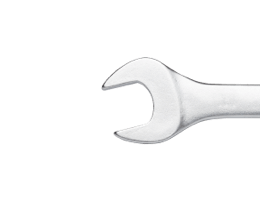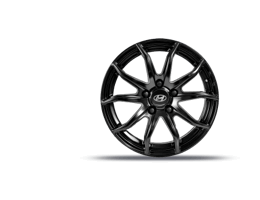- Enhanced edition of the world’s first car with three electrified powertrains offers consumers the option to choose an eco-friendly vehicle that fits their needs
- New IONIQ Electric with upgraded 38.3-kWh battery: 36% added energy storage capacity – now 294km range in total (internal target under WLTP regulations)
- With over 60,000 IONIQs sold since its launch in 2016, the new IONIQ makes clean, connected mobility available for even more drivers
- New IONIQ will launch in Australia in the second half of 2019
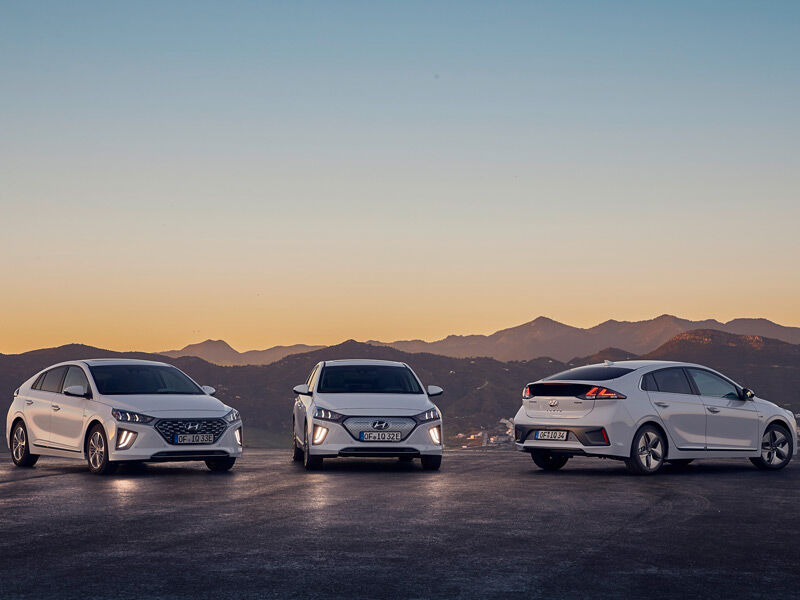
Hyundai Motor is launching comprehensive connectivity and design enhancements for the new IONIQ, the latest edition of its revolutionary eco-friendly model.
When launched in 2016, IONIQ was the world’s first car planned from the start to offer three electrified powertrains – hybrid, plug-in hybrid and full electric. The IONIQ is now already upgrading its offer, with added technological features and a refreshed look. Hyundai keeps leading the way in future mobility, as many other manufacturers are still planning or just launching their first eco-mobility vehicles.
The new IONIQ features advanced connectivity services, SmartSense™ active safety and driving assistance systems and state-of-the-art infotainment features. In addition, both the exterior and interior design receive updates, while drivers of the new IONIQ Electric can also enjoy 36% added energy capacity thanks to an upgraded 38.3-kWh battery.
“Our new IONIQ models build on the success of the first generation thanks to a range of upgrades both in terms of connectivity features and design,” says Hyundai Motor Chief Operating Officer Thomas A. Schmid. “When it comes to Hyundai’s eco-mobility vehicles, IONIQ is leading the way by offering our customers all they need thanks to life-enhancing, easy-to-use technologies.”
IONIQ provides innovative mobility solutions with three electrified drivetrains.
With over 60,000 cars sold since its launch in 2016, the original IONIQ has established itself as one of the main pillars in Hyundai’s progressive future mobility lineup. Together with the trailblazing hydrogen-powered NEXO, which is equipped with a revolutionary fuel cell electric powertrain, and the Kona Electric, Hyundai is the automaker with the widest range of electrified powertrains. The latest edition of the IONIQ is the next logical step to further update this lineup and make clean mobility available for even more drivers.
As the world’s first vehicle to be planned with three distinctly different electrified powertrains, the enhanced new edition of the IONIQ continues the mission of offering consumers the option to choose an eco-friendly vehicle that fits their needs.
The new IONIQ Electric’s battery has been upgraded from 28 kWh to 38.3 kWh, meaning drivers can go even further between charges. It boasts 36% additional energy storage capacity, offering a total of 294kms of range (internal target under WLTP regulations). Its e-motor delivers a maximum power of 100kW and 295Nm of torque and is fitted standard with a 7.2-kW on-board charger - an upgrade from current 6.6-kW – for Type 2 AC charging. Using a 100-kW fast-charging station, the battery can reach 80% charge in as little as 54 minutes.
The new IONIQ Hybrid and IONIQ Plug-in both feature the known Kappa 1.6-litre GDI, direct-injection petrol four-cylinder engine delivering maximum power of 77kW and 147Nm of torque.
The IONIQ Hybrid’s permanent magnet electric motor delivers 32kW with maximum torque of 170Nm, powered by a lithium-ion-polymer battery with 1.56 kWh capacity positioned under the rear seats.
The plug-in version’s electric motor delivers 44.5kW with maximum torque of 170Nm, powered by a 8.9 kWh lithium-ion-polymer battery. In combination with the 1.6-litre GDI engine IONIQ Hybrid and Plug-in deliver a system output of 103.6kW and up to 265Nm of torque. The electric motor enables the IONIQ Hybrid to operate in pure electric mode at speeds up to 120 km/h. Drivers choosing the IONIQ Plug-in can safely rely on 52 kilometres of pure electric driving range (WLTP target figure) powered by the 8.9 kWh battery.
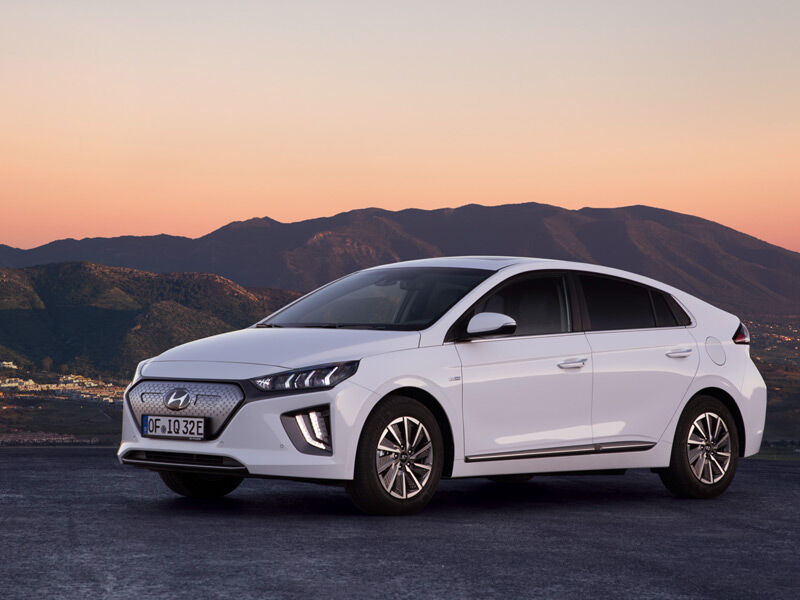
New levels of connectivity in the new IONIQ.
The new IONIQ features Hyundai Blue Link, a connected vehicle system which uses embedded telematics to allow drivers of IONIQ Electric to remote start and stop, while all versions allow remote lock or unlock and control air conditioning via a smartphone app. This technology also allows owners of the plug-in or electric model to remotely check the status of their battery so they know when they need to recharge the vehicle. Thanks to Blue Link, charging can be remotely controlled and scheduled via the app.
With the new IONIQ, Hyundai also introduces eCall, automatically dialing emergency assistance if airbags are deployed or the call button located above the rear-view mirror is pressed. Relevant information (car information, time of accident, driving direction, airbag and impact sensor information) is sent to the local emergency service.
The optional Audio Video Navigation system displays a wide variety of useful information across its 10.25-inch split touch-screen, and features available Cloud-based voice recognition in six languages (with Blue Link). The improved screen can be customised providing two home screen versions and ability to edit displayed widgets and icons.
In addition to standard Android Auto and Apple CarPlay even with the base onboard system, with standard new Multi-Bluetooth function (with 10.25-inch AVN option only) drivers of the new IONIQ can connect two phones at the same time to listen to each phone’s music through Bluetooth streaming.
An updated interior design.
As well as the new convenience features, the new IONIQ’s reimagined interior incorporates new design factors to enhance its sophisticated image. In addition to standard black seat trims, customers have the option of four leather seat colours: Black, Gray two-tone, Red Umber (exclusive for hybrid and plug-in) and Electric Shadow (exclusive to electric version). Meanwhile, the dashboard garnish arrives in Dark Chrome Accent.
Below the new wide screen 10.25-inch AVN screen, the control panel for heating and climate control has been redesigned and sports a sleek, glossy finish. New touch-type control buttons allow for intuitive operation of heating, ventilation and air conditioning. The IONIQ Electric standard high-resolution 7-inch LCD console display (optional for hybrid and plug-in hybrid versions) has been improved with mood lighting to visualise the different drive mode themes. To round off the improved modern interior design, blue ambient lighting has been applied across the passenger-side lower dashboard and the centre console.
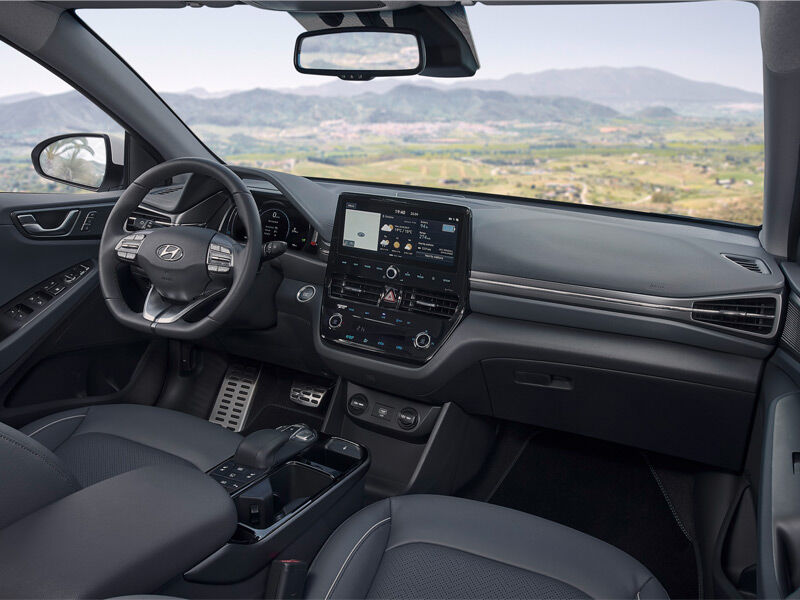
The exterior also gets design upgrades.
Up front, the hybrid and plug-in versions of the new IONIQ now show a redesigned mesh-type radiator grille. The front of the new IONIQ Electric has been updated also with a new distinctive pattern on the closed grille. All models feature an updated front bumper design with a silver-coloured molding at the bottom, and new anthracite seen on the rear bumper molding and daytime running light bezels up front, creating a more refined and dynamic look. The LED DRLs as well as the newly available LED head- and taillights have been completely redesigned to make the IONIQ stand out at night – offering not only aesthetic enhancements but also additional safety. The IONIQ Plug-in and Electric are available with redesigned 16-inch alloy wheels, while customers of the IONIQ Hybrid can choose between a new 15-inch or 17-inch wheel design. The new IONIQ is available in nine exterior paint colours, including four new ones: Fluidic Metal, Electric Shadow, Liquid Sand and Typhoon Silver. Following the outstanding success in its market segment since 2016, IONIQ drivers have been creative in their aesthetic requests, and Hyundai has listened. The other exterior paint colours available to drivers of the new IONIQ are Phantom Black, Polar White, Iron Gray, Intense Blue and Fiery Red.
A leading safety package in the segment.
For a comfortable and safe driving experience, all new IONIQ models are equipped with a comprehensive Hyundai SmartSense technology package. This cutting-edge driver assistance system constantly monitors the environment around the vehicle to protect drivers from potential hazards while on the road. The new IONIQ’s leading safety package includes Front Collision Warning and Avoidance Assist with Pedestrian Detection with new Cyclist Detection ability and Driver Attention Warning. Lane Keeping Assist and High Beam Assist also come standard. Optionally available as well are Lane Following Assist which keeps the car in the middle of a lane so drivers can navigate safely even in heavy traffic during rush hour, and Intelligent Speed Limit Warning that uses the front camera and information from the navigation system to identify road speed signs and displays the speed limit and no-passing signs in real time. Using the radar sensor to detect the distance from the car in front, Smart Cruise Control with Stop&Go and Leading Vehicle Departure Alert maintains a preset distance to automatically stop and depart again according to traffic conditions. Additional options include Blind-Spot Collision Warning and Rear Cross-Traffic Collision Warning.
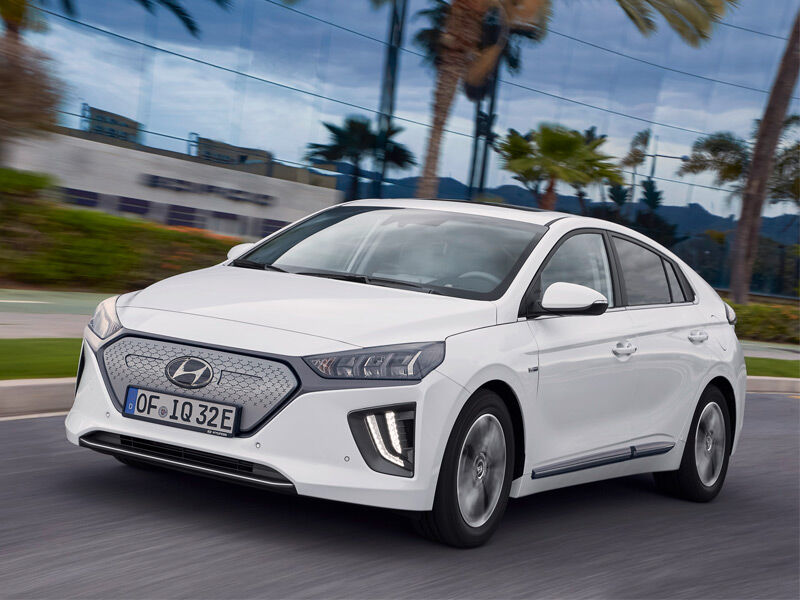
Eco-Driving Assist System: State-of-the-art technology to improve fuel economy.
The new IONIQ Plug-in and Hybrid are equipped with the Eco-Driving Assist System (Eco DAS) to help improve fuel economy. The integrated Coasting Guide analyses road information from the navigation system to notify the driver when deceleration (for example change of directions, cross-roads, highway exits) is imminent. The feature aims to reduce fuel consumption and minimise brake usage. The Coasting Guide can be activated when in Eco mode between 40 and 160 km/h. Eco DAS is further equipped with a Predictive Energy Management system, which manages charging and discharging of the battery in uphill and downhill situations to maximise the battery usage. When a lack of battery state-of-charge is predicted during uphill driving, the IONIQ Plug-in and Hybrid increase internal-combustion engine operation to charge the battery. When a sufficient battery state-of-charge is reached during downhill driving, e-motor intervention increases to minimise fuel consumption and further energy is simultaneously recovered through regenerative braking.
Enhanced driving features.
Thanks to IONIQ’s renowned dynamics and performance, drivers of the new IONIQ Hybrid and Plug-in versions can enjoy the fun-to-drive aspect of a well-built electrified car with the responsive shifts of a 6-speed dual-clutch transmission. New IONIQ customers also benefit from a low centre of gravity due to the low placement of the battery pack, thus increasing even more the fun characteristics of the drive. The hybrid and plug-in versions of the new IONIQ feature Adjustable Regenerative Braking in Eco mode, which allows drivers to select from different intensity levels via the paddle shifters. In Sport mode the paddles act as manual shifters. Taking a cue from its similarly innovative Kona Electric sibling, as a maximum use of regenerative braking technology, the new IONIQ Electric adopts 1-pedal driving capability, which allows drivers to stop the car by simply holding onto the left paddle shift lever with often no need to engage the braking pedal. Working thus via Smart Regenerative Braking, the level of energy recuperation is automatically adjusted depending on the road incline and traffic situation in front when coasting. The new IONIQ Electric also features Eco+, which supplements the standard Eco, Comfort and Sport driving modes. By selecting the Eco+ mode, drivers reduce their energy consumption and the car’s remaining energy can be extended during unforeseeable emergency situations.
Australian Market.
The new IONIQ will launch in Australian in the second half of 2019. Local pricing and specifications will be announced closer to launch.
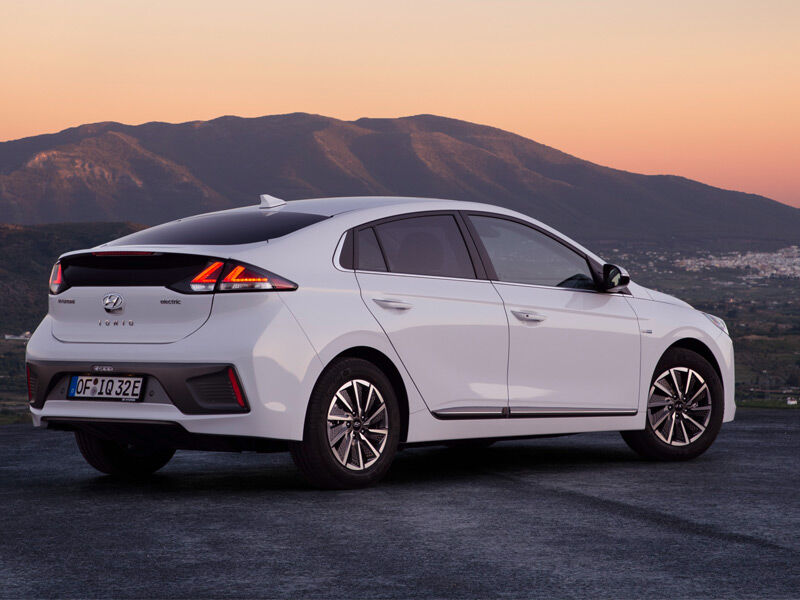
Technical specifications.
| Engine (IONIQ Hybrid and IONIQ Plug-in) | ||||
|---|---|---|---|---|
| Type | KAPPA 1.6 ATKINSON GDI | |||
| Displacement | 1,580 cc | |||
| Bore x stroke | 72 X 97 mm | |||
| Compression ratio | 13.0 | |||
| Power | 105 PS @ 5,700 rpm | |||
| Torque | 147 Nm @ 4,000 rpm | |||
| Electric Motor (IONIQ Hybrid) | ||||
|---|---|---|---|---|
| Type | Permanent Magnet Synchronous Motor | |||
| Maximum Power (kW/PS) | 32 kW / 43.5 PS | |||
| Maximum Torque (Nm) | 170 Nm | |||
| Battery (IONIQ Hybrid) | ||||
|---|---|---|---|---|
| Type | Lithium-Ion Polymer | |||
| Capacity (kWh) | 1.56 kWh | |||
| Power Output (kW) | 42 kW | |||
| Voltage (V) | 240 V | |||
| Electric Motor (IONIQ Plug-in) | ||||
|---|---|---|---|---|
| Type | Permanent Magnet Synchronous Motor | |||
| Maximum Power (kW/PS) | 44.5 kW / 60.5 PS | |||
| Maximum Torque (Nm) | 170 Nm | |||
| Battery (IONIQ Plug-in) | ||||
|---|---|---|---|---|
| Type | Lithium-Ion Polymer | |||
| Capacity (kWh) | 8.9 kWh | |||
| Power Output (kW) | 59 kW | |||
| Voltage (V) | 360 V | |||
| On Board Charger (IONIQ Plug-in) | ||||
|---|---|---|---|---|
| Max. capacity (kW) | 3.3 | |||
| System Output | ||||
|---|---|---|---|---|
| Max Power (kW / PS) | 104 kW / 141 PS | |||
| Max Torque (Nm) | 265 Nm | |||
| Electric motor (IONIQ Electric) | ||||
|---|---|---|---|---|
| Type | Permanent Magnet Synchronous Motor | |||
| Maximum Power | 136 PS | |||
| Maximum Torque | 295 Nm | |||
| Maximum speed | 165 km/h | |||
| CO2 combined (g/km) | 0 | |||
| All electric range (target WLTP) | 294 kms | |||
| Battery (IONIQ Electric) | ||||
|---|---|---|---|---|
| Type | Lithium-ion Polymer | |||
| Capacity (kWh) | 38.3 kWh | |||
| Power Output (kW) | 113 | |||
| Energy Density (kwh/kg) | 112.4 (w/o battery heater) 111.2 (w/ battery heater) |
|||
| Voltage (V) | 319.4 | |||
| On Board Charger | ||||
|---|---|---|---|---|
| Max. capacity (kW) | 7.2 | |||
| Charging Time | ||||
| Charge Time to 80% (from “0%” indicated)/ Standard AC | Minimum 6 hrs 5 mins | |||
| Charge Time to 80% (from “0%”)/ Quick Charge DC | @ 50 kW charge point: Approx. 57 min @ 100 kW: Approx. 54 min | |||
| Transmission (IONIQ Hybrid & Plug-in) | ||||
|---|---|---|---|---|
| Automatic | 6-Speed Dual Clutch Transmission | |||
| Transmission (IONIQ Electric) | ||||
|---|---|---|---|---|
| Automatic | Single Speed Reduction Gear | |||
| Gear ratios (IONIQ Hybrid) | ||||
|---|---|---|---|---|
| KAPPA 1.6 ATKINSON GDI / 6 DCT | ||||
| 1st | 3.867 | |||
| 2nd | 2.217 | |||
| 3rd | 1.371 | |||
| 4th | 0.930 | |||
| 5th | 0.956 | |||
| 6th | 0.767 | |||
| Reverse | 5.351 | |||
| Final drive | 4.188 / 3.045 (1ST-4TH / 5TH - Reverse) | |||
| Gear ratios (IONIQ Electric) | ||||
|---|---|---|---|---|
| Single Speed Reduction Gear/ 38.3 kWh Battery | ||||
| Gear ratio | 7.412 | |||
| Suspension and damping | ||||
|---|---|---|---|---|
| Front | Macpherson Strut Type with Gas shock absorbers | |||
| Rear | Multi-link Type (IONIQ Hybrid) and Torsion Beam Type (IONIQ Electric) with gas shock absorbers | |||
| Steering (IONIQ Hybrid and IONIQ Plug-in) | ||||
|---|---|---|---|---|
| Type | Rack & Pinion | |||
| Gearing | 2.66 turns lock-to-lock | |||
| Turning radius | 5.3 metres (minimum) | |||
| Overall Steering Gear Ratio | 13:9:1 | |||
| Steering (IONIQ Electric) | ||||
|---|---|---|---|---|
| Type | Rack & Pinion | |||
| Gearing | 2.85 turns lock-to-lock | |||
| Turning radius | 5.3 metres (minimum) | |||
| Overall Steering Gear Ratio | 15:1:1 | |||
| Brakes (all models) | ||||
|---|---|---|---|---|
| Front (Diameter) | 280 mm | |||
| Rear (Diameter) | IONIQ Hybrid: 262 mm IONIQ Plug-in and IONIQ Electric: 284 mm |
|||
| Assistance | ABS, EPB (Std. EV, Opt. HEV/PHEV), ESC and AEB | |||
| Wheel type (IONIQ Hybrid) | Tyres (IONIQ Hybrid) |
| 6.0J x 15-inch alloy wheels | 195 / 65 R15 |
| 7.0J x 17-inch alloy wheels | 225 / 45 R17 |
| Wheel type (IONIQ Plug-in) | Tyres (IONIQ Plug-in) |
| 6.5J x 16-inch alloy wheels | 205 / 55 R16 |
| Wheel type (IONIQ Electric) | Tyres (IONIQ Electric) |
| 6.5J x 16-inch alloy wheels | 205 / 60 R16 |
| Exterior (mm) | ||||
|---|---|---|---|---|
| Overall length | 4.470 | |||
| Overall width | 1.820 | |||
| Overall height | 1.450 | |||
| Wheelbase | 2.700 | |||
| Ground clearance | 140 | |||
| Front overhang | 880 | |||
| Rear overhang | 890 | |||
| Wheel tread (front) | IONIQ Hybrid: 1.563 / 1.549 (15’’/17’’) IONIQ Electric: 1.555 (16’’) |
|||
| Wheel tread (rear) | IONIQ Hybrid: 1.563 / 1.549 (15’’/17’’) IONIQ Electric: 1.555 (16’’) |
|||
| Interior (mm) | First row | Second row |
| Head room (With/without sunroof) |
994 / 1,024 (970 / 1,004) | 950 |
| Leg room | 1.073 / 1,136 | 906 / 800 |
| Shoulder room | 1.425 | 1.396 |
| Hip room | 1.366 | 1.344 |
| Capacities (litres) | ||||
|---|---|---|---|---|
| Fuel tank | IONIQ Hybrid: 45 IONIQ Plug-in: 43 |
|||
| Luggage (l VDA) |
IONIQ Hybrid: min 456 l / 563 l / max 1518 l (VDA 211/ 213 /214) IONIQ Plug-in: min 341 l / 446 l / max 1401 l (VDA 211/ 213 /214) IONIQ Electric: min 350 l / 455 l /max 1410 l (VDA 211 / 213 / 214) |
|||
| Weight (IONIQ Hybrid) | ||||
|---|---|---|---|---|
| Curb weight (kg) (in running order without driver) |
1.361 | |||
| Maximum Payload | 509 | |||
| Gross Vehicle Weight (kg) | 1.870 | |||
| Weight (IONIQ Plug-in) | ||||
| Curb weight (kg) (in running order without driver) |
1.495 | |||
| Maximum Payload | 475 | |||
| Gross Vehicle Weight (kg) | 1.970 | |||
| Weight (IONIQ Electric) | ||||
| Curb weight (kg) (in running order without driver) |
1.420 | |||
| Maximum Payload | 460 | |||
| Gross Vehicle Weight (kg) | 1.880 | |||
